Yesterday in a hotly contested matchup for the third spot in the Faithful Four, Gobnait stung Ignatius of Loyola 51% to 49%. She joins Martha of Bethany and Pandita Ramabai in the rarified air of Lent Madness 2019.
Who will make the Faithful Four the quartet to which it's called? We'll find out in the next 24 hours as John Chrysostom faces off against Zenaida for the final spot. To make it this far, John defeated Margaret of Cortona and Marina the Monk, while Zenaida took down Apollonia and Nicholas of Myra.
Then take a deep cleansing breath and get ready for the last three battles of Lent Madness 2019. On Monday and Tuesday it’s the Faithful Four. And then on Spy Wednesday the scene will be set as we collectively crown the Golden Halo winner. The end is near!
John Chrysostom
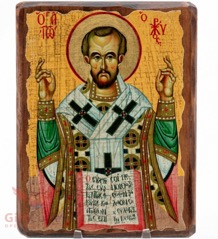 There is no better way to honor the man who so tirelessly advocated for care of those who lived in poverty than by spending your pennies on pious excess. And for you, dear Lent Madness faithful, I have limited all my searches to eBay and Amazon so you can go find these gems and purchase them for yourself, if you so please.
There is no better way to honor the man who so tirelessly advocated for care of those who lived in poverty than by spending your pennies on pious excess. And for you, dear Lent Madness faithful, I have limited all my searches to eBay and Amazon so you can go find these gems and purchase them for yourself, if you so please.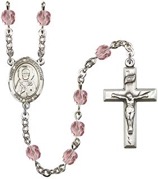
The easiest finds are his books. SO MANY BOOKS by him and about him. Those are boring pictures though, so I’ll let you find those on your own.
After books, there are so many traditional things you’d expect to find. Like the lovely icon above. Or this nifty rosary. You can find it with blue beads too.
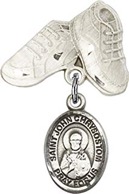 But perhaps you want more peculiar religious paraphernalia. Like this John Chrysostom medal attached to tennis shoes.
But perhaps you want more peculiar religious paraphernalia. Like this John Chrysostom medal attached to tennis shoes.
Because in addition to soaring oratory, Good St. John also had literal hops, apparently.
 One of my favorite finds was this “Aromatic Scroll.”
One of my favorite finds was this “Aromatic Scroll.”
The description from the seller is worth reading in full: “Made with pure beeswax, mastic and incense… It emits a very distinct odor due to the incense from Mount Athos creating an atmosphere similar to an Orthodox church or to a Monastery (emphasis original)". I wonder if they have one that comes in the “distinct odor” of church basement.
 Apparently beeswax is common with John Chrysostom. Maybe for its golden hue? Anyhow, a Chrysostom search in “Home and Kitchen” will yield this find: a pine cone shaped beeswax candle. Go figure.
Apparently beeswax is common with John Chrysostom. Maybe for its golden hue? Anyhow, a Chrysostom search in “Home and Kitchen” will yield this find: a pine cone shaped beeswax candle. Go figure.
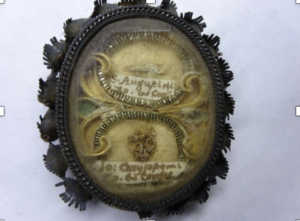 But perhaps these items are not spectacular enough for your religious sensibilities. Fear not, for I have found on the eBays this fantastic reliquary.
But perhaps these items are not spectacular enough for your religious sensibilities. Fear not, for I have found on the eBays this fantastic reliquary.
What is most amazing about this find is that it is a two-fer! You get a relic of both St. Augustine and St. Chysostom. I don’t know about you, but when I think of pairing saints, those two come immediately to mind. You may be worried about the transmission of human remains on an e-commerce site but the seller assures us that “As per eBay policy, this reliquary does not contain human remains but only objects of devotions.”
I am so curious as to what that gray blob is and who on earth would want to show it devotion. Also, if the selling of relics strikes you as somehow a little wrong, again the seller reminds us that the “Relic is free, only the theca is on sale.” $995 seems steep for that if you ask me.
But perhaps you don’t want explicitly religious items. You want to show your Chysostom fandom in more mundane ways. Well, here’s a nifty St. John bag (list price $450) for you to carry your alms in.
This stylish tote also has easy access so you can quickly grab coin when you see someone in need.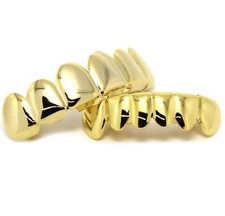
Maybe such a purse is too ostentatious for you. Maybe you’d prefer something more subtle to show your support. Might I suggest your own “golden mouth” imitation with this fab grill?
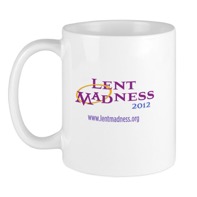 In truth though, there just is not enough sacred kitsch out there for John. Should he win this year’s Golden Halo, you, dear voter, will have graced the world with the most kitschy of sacred devotion, a Lent Madness mug.
In truth though, there just is not enough sacred kitsch out there for John. Should he win this year’s Golden Halo, you, dear voter, will have graced the world with the most kitschy of sacred devotion, a Lent Madness mug.
Zenaida
 Medicine during the time of Jesus was an odd combination of spells, chants, prayers, herbs, rituals, and instruments of torture. To apply a scholarly approach in conjunction with Christian practice was indeed a cutting-edge approach by Zenaida and her sisters. To provide this care for free, was simply unheard of.Since there is no Etsy or Ebay store committed to Zenaida kitsch (what’s with that?), let me immerse you in the medical practice of common human ailments. Treatment of disease revolved around manipulating what was thought as the four humors: blood, phlegm, black bile, and yellow bile.
Medicine during the time of Jesus was an odd combination of spells, chants, prayers, herbs, rituals, and instruments of torture. To apply a scholarly approach in conjunction with Christian practice was indeed a cutting-edge approach by Zenaida and her sisters. To provide this care for free, was simply unheard of.Since there is no Etsy or Ebay store committed to Zenaida kitsch (what’s with that?), let me immerse you in the medical practice of common human ailments. Treatment of disease revolved around manipulating what was thought as the four humors: blood, phlegm, black bile, and yellow bile.
Colds and Flu have plagued humans since the beginning of time. Satan sneezed and infected us all. Along with prayers and chants, colds and flu were treated with leeching of the blood since most diseases were attributed to the work of Beelzebub.
Frankincense and Myrrh were given to baby Jesus because of their value in treating common diseases. Both are known to have antiseptic properties and can aid with digestive problems and improve oral healthcare. F and M were the ancient equivalents of our current use of antibiotics. And if you think that pharmaceutical companies over charge now, these two babies were probably worth MORE than the gold Jesus was given.
Got a tapeworm? Who has tapeworms these days? Back then, tapeworms, dysentery, vomiting, and other gastric fun times were all too common. Pomegranate would have been the “go-to” treatment by Zenaida and her sisters.
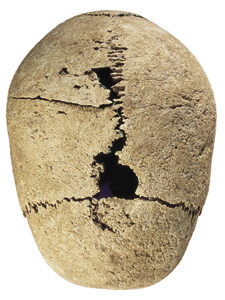 Got a head injury? Much like today, but without ascetic technique, physicians would drill holes in the skull in order to relieve intracranial pressure to allow the brain to heal. This is the skull of one such human having undergone a craniotomy. What’s more surprising is that although a number of people died following the procedure, archeological evidence suggests many more survived.
Got a head injury? Much like today, but without ascetic technique, physicians would drill holes in the skull in order to relieve intracranial pressure to allow the brain to heal. This is the skull of one such human having undergone a craniotomy. What’s more surprising is that although a number of people died following the procedure, archeological evidence suggests many more survived.
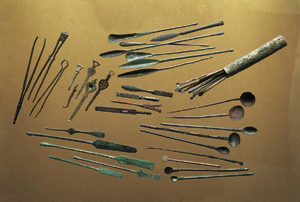 Wounds from war and tribal infighting were treated with tools from the kitchen and garden shed. Spoons were used to scrape out infected cuts, saws were used for amputation, forks were used as probes, and of course knives were used to slice open human flesh.
Wounds from war and tribal infighting were treated with tools from the kitchen and garden shed. Spoons were used to scrape out infected cuts, saws were used for amputation, forks were used as probes, and of course knives were used to slice open human flesh.
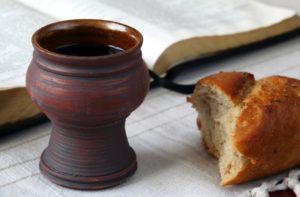 And finally, wine. Wine was used to disinfect wounds; treat anxiety; and hydrate (since it was often safer than water). And lest we forget, the gift of wine (and bread) is our promise from the Great Physician that while our physical ailments may not be cured, that there is greater healing in store for us in the Kingdom of Heaven. Zenaida knew that any of her treatments were for naught if God was not a part of the healing process.
And finally, wine. Wine was used to disinfect wounds; treat anxiety; and hydrate (since it was often safer than water). And lest we forget, the gift of wine (and bread) is our promise from the Great Physician that while our physical ailments may not be cured, that there is greater healing in store for us in the Kingdom of Heaven. Zenaida knew that any of her treatments were for naught if God was not a part of the healing process.
[poll id="266"]
127 comments on “John Chrysostom vs. Zenaida”
Zenaida for me because of (or in spite of?) her best medical practices of the day; more importantly, Zenaida because free medical care for all. Let an enlightened Congress work out the details. On the other side, what’s with pairing Augustine with John Chrysostom, since the former is considered heterodox by the Orthodox?
I'm definitely in favor of Julian and Oscar though I would hate to have to choose between them!
"Enlightened congress?" I think I'm more likely to see St. Nick! (I agree with you, but will it ever happen?)
Ew! After reading today’s down-lo on Zenaida’s likely uh, ‘medical practices’, I almost reconsidered my high esteem of this person. (Which I only recently acquired via Lent Madness!) Today’s version of Zenaida depicts a war criminal. I can’t wait to see who is on display in the final 4, especially if paired with Gobnait, whose saintly devotion directed bee swarms.
Yes, those descriptions made me not want to vote for either one! Must google both again!
Her medical practices were common at the time, with one exception, she treated everyone, regardless of ability to pay.
Thank God medical practices have improved. Now if we could just get single-payer health care for all in the US.
Had to go back to the original bios to remember John's legacy wasn't just about pretty words, but a track record of speaking truth to power. Something we always need more of.
Very disappointed that so many mythical people are winning over REAL people. If it is a plot to make sure Martha wins, I will accept the vote. But most of these are "WHO?"
Not sure why people involved in religion yet insist that all its figures be "real." How exactly do we know that God is "real"? Insofar as humans are "real," Zenaida is "real." Here is her entry in Wikipedia:
Saints Zenaida and Philonella (d. circa 100) were traditionally the first Christian physicians after Luke the Evangelist, and the first "unmercenaries" (physicians who would not accept fees from their patients). They are particularly venerated in Eastern Christianity. Zenaida and Philonella were sisters, born into a well-educated Jewish family and said to be cousins of Paul the Apostle. They were instructed and baptized into the Christian faith by their brother Jason, who was bishop of their native city of Tarsus. On entering the philosophical academy at Tarsus, they devoted themselves to the study of medicine, and when they completed their studies moved to the mountains around Pelion near Demetriada in Thessaly. This was a region renowned for its healing springs and shrines to Asclepius. The physicians who practiced there catered to the wealthy, charging exorbitant amounts for their services, and augmented their incomes with the sale of magical amulets and charms. The sisters set themselves in opposition to the prevailing custom. On locating a cave with a mineral spring, they set up a chapel and cells for themselves, and opened a clinic where they treated all who came to them regardless of their ability to pay. Zenaida was particularly interested in pediatrics. Toward the end of her life she paid particular attention to the treatment of psychiatric disorders, including clinical depression.
I don't know if they are cousins of Saul/Paul, but since they are also from Tarsus, the story is at least coherent. Zenaida means "from Zeus." I like the syncretism of pagan/Jewish/Christian. It seems very multicultural. I am not sure if in the hellenistic period we really can separate all the cultural and religious strands. If Zenaida comes up against Martha, I don't know what I am going to do. I value both women greatly and appreciate the models they provide for today. Personally I find it fascinating to expand my sense of spiritual and moral possibilities. Go, Jewish Zed sisters!
This is my LM pet peeve: the reality check. I dare say Jesus himself would not pass it: he’s never been photographed and, save for a vague mention from Josephus, isn’t in any contemporaneous writings. This kind of reality test isn’t even as helpful as the Velveteen Rabbit test—all hair and whiskers completely “loved off.”
Also, WHO stands for World Health Organization, so vote for the physician.
Today’s not my day. I don’t feel the love for either one of these. And Anna’s write up - Yeesh! Had to pick one so went with John. Anxiously awaiting tomorrow.
Oh, my! When I voted it was a dead heat! Go do a bit of shopping, and suddenly there has been a serious widening of the gap! (In favor of my candidate, so I am not complaining!)
Wow! Am I the only one to notice that it SEEMS as though the Faithful Four will be all women?
If it does turn out that way, will this be the first time for such a happening?
If you read the comments above, you’ll find that it has been discussed today. And in the comments from a few days ago, there were actual percentages that debunked the idea that minorities always win the daily matchups. And even if it were true, why would it matter? This whole thing is for FUN; it’s not like we’re shaking up heaven or anything.
No you are not.
See many of the earlier comments posted.
I am a Canadian nurse, could I vote for anyone but a Saint who advocated Universal Health Care?
I have noticed that the current cultural/political zeitgeist seems to inform the votes, and thus the winner of the Golden Halo. Does anyone else see this phenomenon? Just curious.
Following the comment threads on a real or perceived gender bias, I recalled thinking there were other biases in years past: e.g., the modern saint (better documentation) always winning over the ancient saint (scanty paper trail or possibly mythical) or a bias towards any saint who saved people from and/or fought the Nazis. So I went to the available data on the website and complied a nifty table looking back at the prior results. Unfortunately I cannot figure out a way to paste it here and retain the formatting, so I had to retype and hope the spacing holds. If it does not, the columns left to right are: Year, Women in the Initial 32, Women in the Faithful Four, and the Golden Halo Winner.
Year Women in 32 Women in Faithful Four Golden Halo Winner
2019 16 4 (if trend holds) TBD
2018 14 3 Anna Alexander
2017 10 2 Florence Nightingale
2016 11 3 Dietrich Bonhoeffer
2015 14 3 Francis
2014 9 2 Charles Wesley
2013 12 2 Frances Perkins
2012 9 3 Mary Magdalene
2011 6 2 CS Lewis
2010 4 2 George Herbert
What is apparent is that the SEC have progressively moved towards gender parity in creating the brackets, finally achieving it this year with 16 women in the 2019 bracket of 32. And it seems that women have been well represented in the Faithful Four and the Golden Halo, where men hold a slight lead of 5 to 4 which will balance out this year.
There does seem to be bias towards modern saints for the GH, with the exceptions of Mary Magdalene and Francis.
So now you all have something else to chew on while waiting for the Faithful Four.
Thanks for the analysis! So this IS the first all-female final four. And it's interesting, though I already felt people voted more for modern saints, to see that half of the GH winners lived in the 19th or 20th century.
Yes, I find the analysis very helpful—that is, it helps moderate our more passionate and contentious hunches. It is also interesting that in this first-ever, all-female Final Four, we have a square-off between one modern saint, and three non-moderns, bucking a different trend. ... Does no good to put regular people or saints in boxes, IMHO.
The bias toward modern saints is one of the considerations that led to the creation of the 4 bracket quadrants that started last year. Prior to 2018, no way would Gobnait have made it to the Final Four. I really like the bracket quadrants and hope they will be a permanent feature of Lent Madness.
Thank you so much for the historical data analysis, Deborah! I have a similar interest in reviewing past information with an eye toward a deeper understanding of Lent Madness.
I'm new to LM, so I'm still learning about the process and the voting patterns. Based on this year's process, it seems pretty clear to me that the daily write-up by the Celebrity Bloggers carries far more weight than the discussion we engage in here. Although, I haven't verified this, I'm reasonably confident that there are considerably less than 100 commenters;by contrast there are an average of 8000 votes cast daily (though the overall trend is downward each voting day during Lent).
I agree - far more vote than comment. So the comments are not necessarily reflective of the Lent Madness voting public. I also agree that the Celebrity Bloggers have enormous powers of persuasion.
I love this data!! Thank you for sharing. I think your observation about Nazi fighting speaks to our cultural fascination with WW2, but I can’t say I’m immune. I loved learning about Dietrich and Maria Skobtsova.
Interestingly enough, I checked Past Golden Halo Winners on page 15 of my Saintly Scorecard to see how many women and how many men had won in past years. It was interesting to see that not only were the genders very nearly equal, but that not all the "winners" were 20th century folks.
Mary Magdalene (2012) is probably the farthest back in time and Frances Perkins (2013) the most recent, with George Herbert (2010) and Charles Wesley (2014) in the middle.
Zenaida gets my vote , provider of free medical care . What wonderful sacrificial love that represents !
Well, even though John has the kitschiest kitsch today, I can't forsake Zenaida. I am awed by her faith, her learning and her commitment to healthcare for all.
Great kitsch writeups for both today. The comments are also thoughtful. I have to remind myself that many of the saints lived in times very different from our lives now. I hope that we human beings have made great strides in our knowledge and understanding of issues such as religious or ethnic enmity and gender roles. Jesus told the disciples that He still had much to teach us, so would send the Holy Spirit to enlighten us as we became able to understand. I want to believe that saints such as John would not have such antisemitic views if he lived in the 21st century. I live in hope that all of us can undergo the process of redemption as we listen to the Spirit and turn away from past sins toward a better understanding of God's radical love. We humans still have a long way to go, but "I will, with God's help."
I hate to be a prude, but this year's LM comments have been a turn off for me.
I don't see poems, made up songs, and down right silliness has a lot to do with my spiritual studies of lent. I have always enjoyed reading about the saints but I fear I will have to call it quits.
Then, I very respectfully suggest that you skip reading the comments. Take some space over the weekend. I’d hate for you to stop altogether at this point as I’ve always found the Celebrity Bloggers’ write-ups for the Faithful Four to be the most thoughtful and moving of the entire exercise. Peace.
Anna Fitch Courie has guided a saint to victory the past two years, and her gifted creative blogging is on full display today with Zenaida. Dear powers that be on the SEC, may she finally become a Distinguished Celebrity Blogger??
Prima Blogger Assoluta
My heart says Zenaida, and I have enjoyed Anna Courie's writing for a few years here, "There is no better way to honor the man who so tirelessly advocated for care of those who lived in poverty than by spending your pennies on pious excess." got me. John Creech, good one!
It intrigued me the men vs women voting discussion and the potential of the impact of voting based on the gender of who is voting. But I have this question, does anyone track the success of the authors who have put time in to teach so much about all of these saints, both known and unknown. Is there a writer whose candidates have won more often?? I believe the effectiveness of the argument has great sway in this Madness. I think those individuals should be equally recognized.
I assembled this data after drawing the same conclusion as you! My dear friend who originally introduced me to Madness often commented on the power of the writing to sway voters; after all, it may be the only information some may ever read about that saint.
Golden Halo winners
2010: George Herbert (Scott Gunn)
2011: C S Lewis (Neil Alan Willard)
2012: Mary Magdalene (Meredith Gould)
2013: Frances Perkins (Heidi Shott)
2014: Charles Wesley (David Sibley)
2015: Francis of Assisi (Laurie Brock)
2016: Dietrich Boenhoffer (Beth Lewis)
2017: Florence Nightingale (Anna Courie)
2018: Anna Alexander (Anna Courie)
2019 Faithful Four:
Martha of Bethany (Amber Belldene)
Pandita Ramabai (Amber Belldene)
Gobnait (David Hansen)
Zenaida (Anna Courie)
This year, we will have either a first-time champion blogger, or we will see Anna Courie take her third consecutive victory.
And Amber has a 50% chance of winning.
But Zenaida is my first choice, followed by Pandita
Yes, indeed
John Chrysostom authored at least one prayer in our prayerbook, and it's a pretty good one.
At the same time, it is difficult to pass up a female doctor when my much loved niece is one.
I’m writing not to vote, but to comment. A Canadian senior, I was raised in midwestern Canada, and we worshipped in informal conservative evangelical churches. As an adult, I have continued to learn and worship in several churches of rhe Christian an Missionary Alliance, for over 50 years. A couple of years ago, a neighbour lent me a copy of The Anglican Journal (long story, will skip ahead). Intrigued by the depth of the theology, the obvious intellect, and the sincere message and practice; I signed up for email newsletters, and there discovered Lenten Madness among some other gems of faith..
I have been entertained, enlightened, heartened, and blessed. Conservative protestants are not purveyors of Saintly information — no Feast Days for Saints or those kinds of commemoration. So I have been enjoying a delightful flow of new and inspiring information and delightful comments. I am a fan of words, and there were many!
There are no specific Lenten practice in our church, although Good Friday and Easter Sunday are important and special services. I have adopted Lenten Madness as my own Lenten observance. I delight in the inclusive biographies, the carefully crafted comments, the songs and the limericks. I have learned about faithful believers whose very existence was unknown to me. Thank you to all the authors and commenters.
And now for something completely different:
If any dear readers are having difficulty remembering Canadian geography, I live in Saskatoon (a city) in the province (“state” in U.S. parlance) of Saskatchewan, in the country of Canada. You can find my location on a map of North America. That would be about 350 miles north of North Dakota’s northern border, or possibly right past the top edge of the map paper, depending on how much of North America your map maker chose to display.
That last paragraph was included to illustrate how far the Lenten Madness has spread.
As the mother of a son who is one of the good guys, I understand what you're saying. The proverb that may (clumsily perhaps) sum it up is "Two wrongs don't make a right."
Thank you for your story. Thank you for joining us on this virtual pilgrimage to Canterbury. I for one hope to see you here again.
I echo the thanks, the praise, and the sentiment. “Stay with us,” as they say on the news.
And David Oakerhater.
I live in the Pittsburgh area, near my home town, but my husband and I lived in Labrador City for five years and six winters, and in Corner Brook, Newfoundland & Labrador for 25 years. We have been back "home" for 4 years, and I still miss much about Canada, but not, to be honest, the winters. I do miss the northern lights in Labrador, which I could see often. I discovered Lent Madness when I became an Episcopalian after returning to Pennsylvania. I buy the bracket poster every year for our parish. Not only is Lent Madness fun, but I've learned so much. I have been trying hard to get Dr. Wilfred Grenfell into the contest, but no luck so far. He gave his whole life for the northern peninsula of Newfoundland and for Labrador. Enjoy the rest of Lent Madness!
Saskatoon, Saskatchewan is my absolute favorite place name in the whole world.